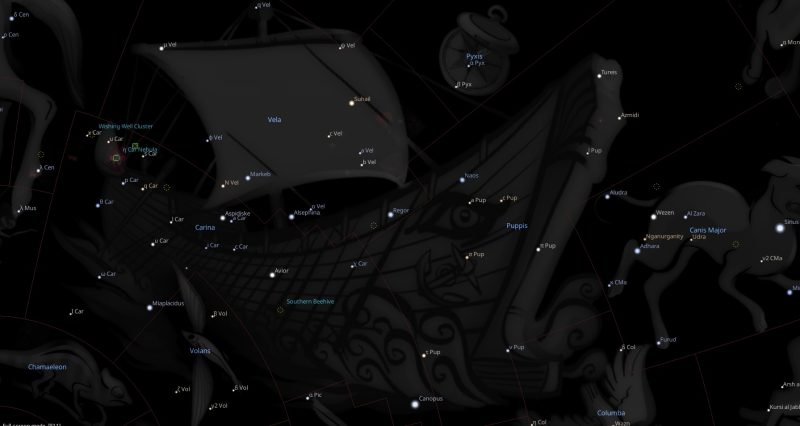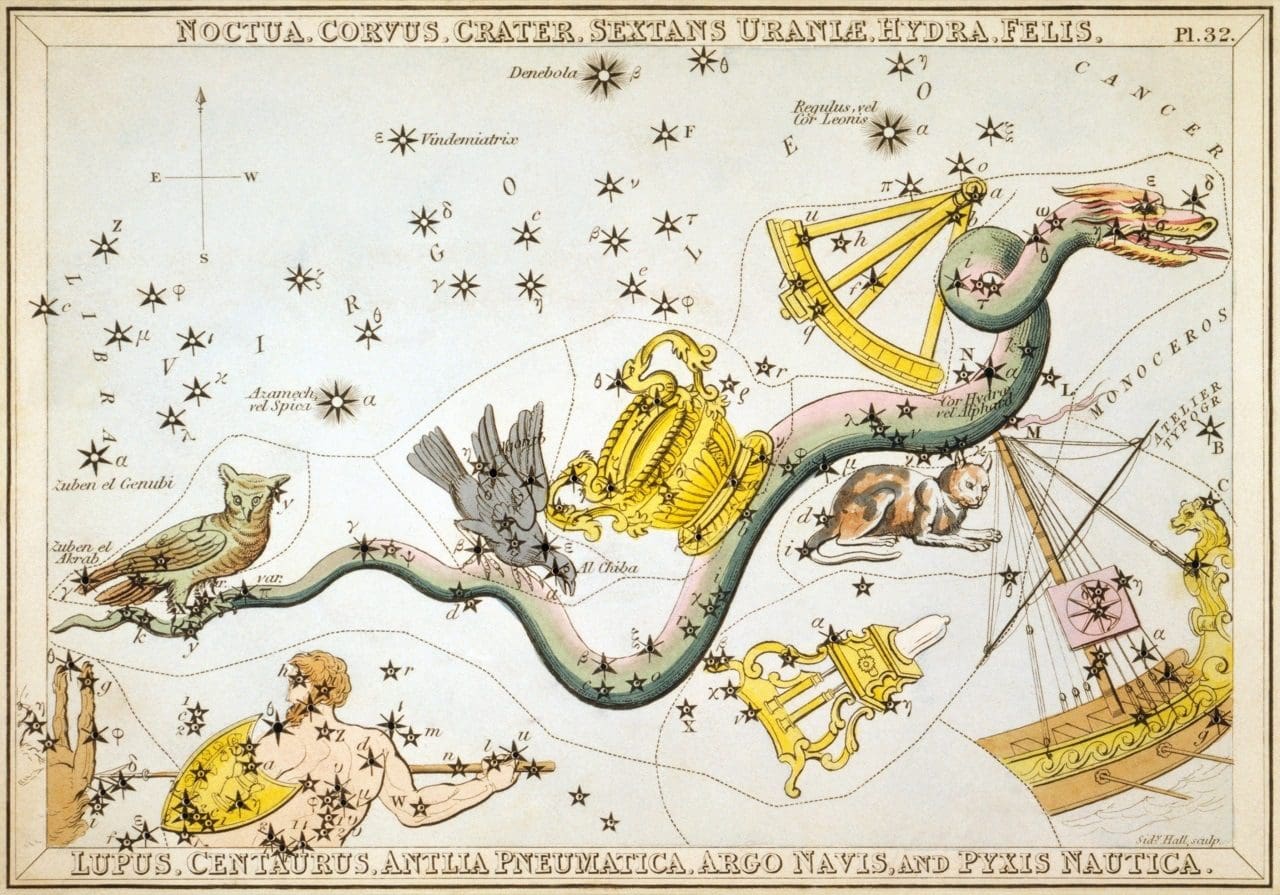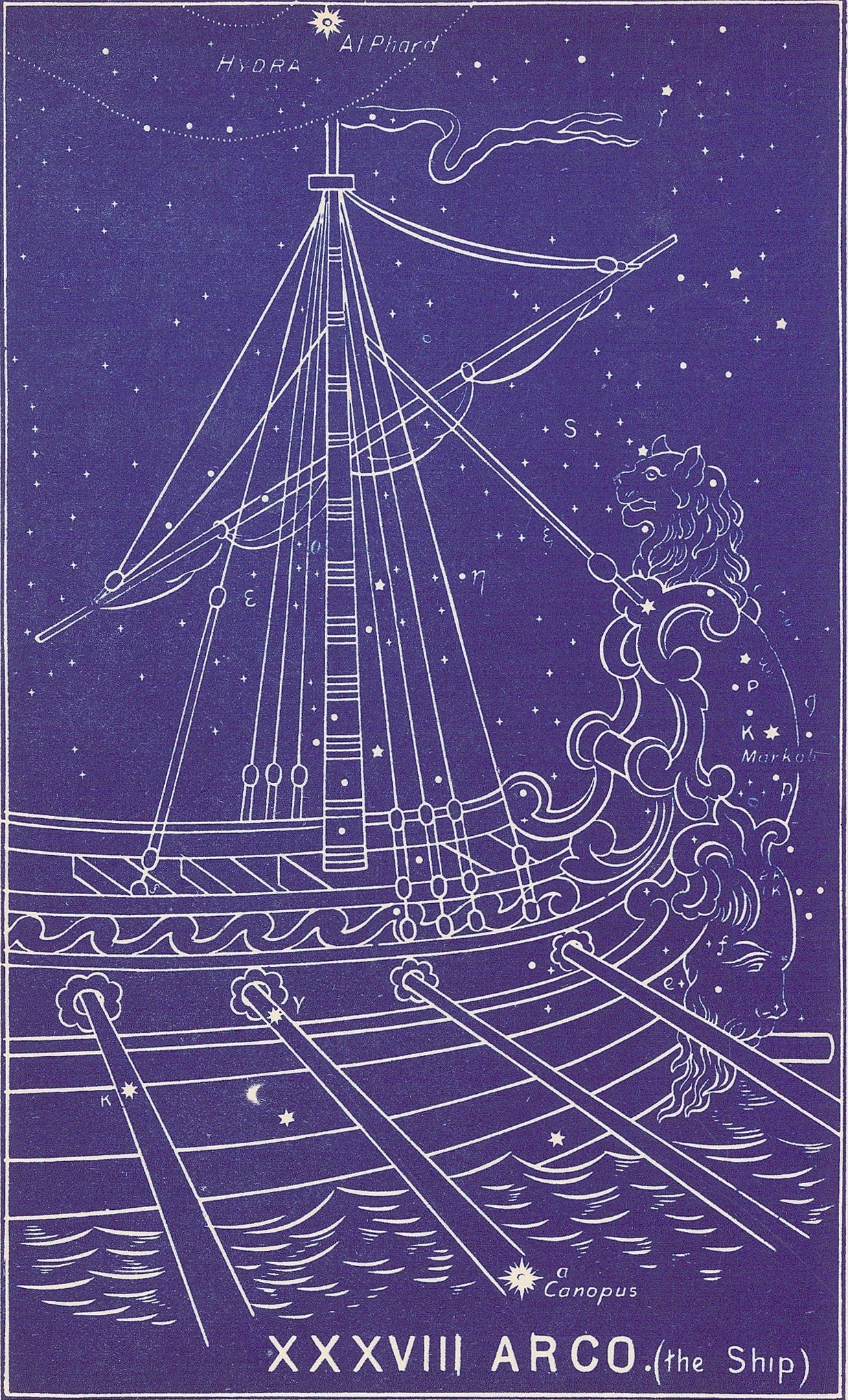FIXED STARS: Major Stars | 1000+ Stars | Constellations | About
The obsolete constellation Argo Navis the Ship is a southern constellation bordering Canis Major, Monoceros, Hydra, Antlia, Centaurus, Musca, Chamaeleon, Volans, Pictor, Columba and the obsolete constellations Officina Typographica and Robur Carolinum.Argo is one of the 48 constellations listed by Ptolemy in the 2nd century. It spans over 120 degrees of the zodiac from the Signs of Cancer to Scorpio.
In 1763, the Constellation Argo Navis (the Ship Argo) was divided into three smaller ones: Carina (the Keel), Puppis (the Poop Deck or Stern), and Vela (the Sails). They were officially recognized in 1930, and Argo Navis was declared obsolete. Astrologically, Carina, Puppis and Vela are still considered together as Argo Navis.
Abbreviation: Arg
Genitive: Argûs Navis [1]
Argo Constellation Stars
| 2000 | 2050 | Star | Name | Sp. Class | Mag. | Orb |
|---|---|---|---|---|---|---|
| 14♋59 | 15♋41 | α Car | Canopus | A9 | −0.72 | 2°40′ |
| 17♋10 | 17♋52 | ν Pup | B8 | 3.17 | 1°50′ | |
| 27♋45 | 28♋26 | τ Pup | K0 | 2.94 | 1°50′ | |
| 28♋19 | 29♋01 | KQ Pup | M2 | 4.82 | 1°00′ | |
| 00♌19 | 01♌00 | π Pup | Ahadi | K3 | 2.71 | 2°00′ |
| 00♌26 | 01♌08 | 140 Pup | K3 | 4.98 | 1°00′ | |
| 01♌52 | 02♌34 | 4 Pup | F2 | 5.03 | 1°00′ | |
| 03♌41 | 04♌23 | 6 Pup | K3 | 5.17 | 1°00′ | |
| 05♌54 | 06♌35 | 3 Pup | A2 | 3.94 | 1°30′ | |
| 06♌03 | 06♌45 | ξ Pup | Azmidi | G6 | 3.34 | 1°40′ |
| 07♌01 | 07♌43 | 232 Pup | A1 | 4.61 | 1°00′ | |
| 08♌34 | 09♌16 | 19 Pup | K0 | 4.72 | 1°00′ | |
| 08♌42 | 09♌24 | σ Pup | K5 | 3.25 | 1°50′ | |
| 09♌58 | 10♌40 | 16 Pup | B5 | 4.40 | 1°10′ | |
| 10♌54 | 11♌35 | c Pup | K4 | 3.62 | 1°40′ | |
| 11♌24 | 12♌06 | ρ Pup | Tureis | F2 | 2.83 | 2°00′ |
| 15♌05 | 15♌47 | a Pup | G5 | 3.71 | 1°30′ | |
| 18♌34 | 19♌15 | ζ Pup | Naos | O5 | 2.21 | 2°10′ |
| 27♌22 | 28♌03 | γ2 Vel | Regor | O7 | 1.83 | 2°20′ |
| 00♍44 | 01♍25 | χ Car | B3 | 3.46 | 1°40′ | |
| 06♍33 | 07♍14 | b Vel | F3 | 3.81 | 1°30′ | |
| 07♍30 | 08♍12 | a Vel | A1 | 3.87 | 1°30′ | |
| 11♍12 | 11♍53 | λ Vel | Suhail | K4 | 2.21 | 2°10′ |
| 13♍49 | 14♍31 | c Vel | K2 | 3.75 | 1°30′ | |
| 14♍44 | 15♍26 | ο Vel | Xestus | B3 | 3.60 | 1°40′ |
| 14♍44 | 15♍26 | ψ Vel | F3 | 3.91 | 1°30′ | |
| 18♍57 | 19♍39 | δ Vel | Alsephina | A1 | 1.96 | 2°20′ |
| 23♍08 | 23♍49 | ε Car | Avior | K3 | 1.86 | 2°20′ |
| 27♍00 | 27♍41 | q Vel | A2 | 3.85 | 1°30′ | |
| 28♍54 | 29♍35 | κ Vel | Markeb | B2 | 2.47 | 2°10′ |
| 03♎25 | 04♎04 | a Car | B2 | 3.43 | 1°40′ | |
| 03♎41 | 04♎22 | c Car | B8 | 3.84 | 1°30′ | |
| 04♎13 | 04♎54 | N Vel | Marut | K5 | 3.16 | 1°50′ |
| 05♎20 | 06♎01 | ι Car | Aspidiske | A8 | 2.23 | 2°10′ |
| 05♎57 | 06♎38 | φ Vel | Tseen Ke | B5 | 3.52 | 1°40′ |
| 07♎23 | 08♎05 | p Vel | A3 | 3.84 | 1°30′ | |
| 10♎31 | 11♎13 | μ Vel | Peregrini | G5 | 2.69 | 2°10′ |
| 10♎51 | 11♎33 | i Car | B3 | 3.96 | 1°30′ | |
| 16♎12 | 16♎53 | p Car | B4 | 3.30 | 1°40′ | |
| 17♎04 | 17♎45 | l Car | G5 | 3.69 | 1°40′ | |
| 17♎34 | 18♎16 | r Car | K3 | 4.45 | 1°10′ | |
| 17♎51 | 18♎32 | s Car | F2 | 3.81 | 1°30′ | |
| 20♎04 | 20♎49 | q Car | K3 | 3.39 | 1°40′ | |
| 22♎19 | 23♎01 | η Car | Foramen | B9 | 4.47 | 1°10′ |
| 22♎26 | 23♎08 | u Car | K0 | 3.78 | 1°30′ | |
| 22♎53 | 23♎35 | υ Car | Vathorz Prior | A9 | 2.92 | 1°50′ |
| 23♎11 | 23♎52 | w Car | K3 | 4.58 | 1°10′ | |
| 25♎07 | 25♎49 | x Car | G0 | 3.93 | 1°30′ | |
| 27♎03 | 27♎45 | y Car | A6 | 4.59 | 1°10′ | |
| 29♎11 | 29♎53 | θ Car | Vathorz Posterior | B0 | 2.74 | 2°00′ |
| 29♎27 | 00♏09 | z1 Car | G8 | 4.62 | 1°00′ | |
| 01♏58 | 02♏39 | β Car | Miaplacidus | A1 | 1.67 | 2°20′ |
| 04♏14 | 04♏55 | E Car | B2 | 4.67 | 1°00′ | |
| 07♏26 | 08♏07 | ω Car | Simiram | B8 | 3.29 | 1°50′ |
| 11♏19 | 12♏00 | G Car | F6 | 4.47 | 1°10′ | |
| 13♏23 | 14♏04 | K Car | A2 | 4.72 | 1°00′ | |
| 18♏05 | 18♏46 | I Car | F2 | 3.99 | 1°30′ |
β, η, θ, υ, ω, E, G, I, K, p, q, r, s, u, w, x, y, and z1 of Carinae belonged to the obsolete constellation Robur Carolinum.
Argo Astrology
Robson
ARGO NAVIS. The Ship Argo.
Legend. This constellation represents the ship in which Jason brought the Golden Fleece from Colchis, said to be the first ship ever built.
Influence. According to Ptolemy the bright stars are like Saturn and Jupiter. Argo is said to give prosperity in trade and voyages, and strength of mind and spirit, but it has been observed to accompany cases of drowning, a notable instance being furnished by the horoscope of Shelley, where Argo occupied the 8th house and contained the Sun, Venus and Uranus. Drowning is particularly to be feared when Saturn afflicts the Moon in or from Argo. It is probably on account of this constellation that Virgo, especially the first decanate, is frequently found to be connected with drowning.
Argo was sub-divided by Lacaille into Carina, The Keel; Malus, The Mast; Puppis, The Poop; and Vela, the Sails: but the separate influence, if any, of these divisions is not known.
Magical. Gives security on the waters. [2]
Noonan
In classical astrology it is correlative of events concerning the sea and shipping and of rivers and springs. [3]
Allen
Argo Navis, the Ship Argo, generally plain Argo, lies entirely in the southern hemisphere, east of Canis Major, south of Monoceros and Hydra, largely in the Milky Way, showing above the horizon of New York city only a few of its unimportant stars; but it covers a great extent of sky, nearly seventy-five degrees in length, — Manilius calling it nobilis Argo, — and contains 829 naked-eye components. The center culminates on the 1st of March.
…recent astronomers have subdivided the figure for convenience in reference, and now know its three divisions as Carina, the Keel, with 268 stars, Puppis, the Stern, with 313, and Vela, the Sail, with 248. La Caille, moreover, formed from stars in the early subordinate division Malus, the Mast, Pyxis Nautica, the Nautical Box or Mariner’s Compass, and this is still recognized by some good astronomers as Pyxis. The Ship appears to have no bow, thus presenting the same sectional character noticeable in Equuleus, Pegasus, and Taurus, and generally is so shown on the maps.
Mythology insisted that it was built by Glaucus, or by Argos, for Jason, leader of the fifty Argonauts, whose number equaled that of the oars of the ship, aided by Pallas Athene, who herself set in the prow a piece from the speaking oak of Dodona; the Argo being “thus endowed with the power of warning and guiding the chieftains who form its crew.” She carried the famous expedition from Colchis in Thessaly to Aea in Colchis, in search of the golden fleece, and when the voyage was over Athene placed the boat in the sky.
Another Greek tradition, according to Eratosthenes, asserted that our constellation represented the first ship to sail the ocean, which long before Jason’s time carried Danaos with his fifty daughters from Egypt to Rhodes and Argos, and, as Dante wrote, “Startled Neptune with the aid of Argo.”
The constellation is noticeable in lower latitudes not only from its great extent and the splendor of Canopus, but also from possessing the remarkable variable eta (eta Carina, Foramen) and its enclosing nebula. [4]
Bullinger
This is the celebrated ship of the Argonauts, of which HOMER sung nearly ten centuries before Christ. Sir Isaac Newton puts the expedition of the Argonauts shortly after the death of Solomon (about 975 BC). While Dr. Blair’s chronology puts it at 1236 BC. This is the return of the great emigrant-ship (Argo) and all its company of travellers (for this is the meaning of the word Argo).
In Kircher’s Egyptian Planisphere Argo, is represented by two galleys (as we have two sheepfolds), whose prows are surmounted by rams’ heads; and the stern of one of them ends in a fish’s tail. One of the two occupies four segments of the sphere (from TAURUS to VIRGO), while the other occupies the four from LEO to CAPRICORNUS. One half of the southern meridians is occupied with these galleys and their construction and decoratons. Astronomers tell us that they carry us back, the one to the period when the Bull opened the year (to which time VIRGIL refers); and the other to the same epoch, when the summer solstice was in LEO–“an era greatly antecedent to the Argonautic expedition. How else, they ask, do we account for the one ship having her prow in the first Decan of TAURUS, and her poop in the last decan of LEO? or for one galley being freighted with the installed Bull, and the other with the solstitial Lion?” (Jamieson’s Scientific Display, &c.)
These are the words of an astronomer who knows nothing whatever of our interpretation of the heavens which is set forth in this work. It will indeed be a large vessel, the true Argo, with its company of travellers, “a great multitude which no man can number.” All this is indicated by the immense size of the constellation, as well as by the large number of its stars. There are 64 stars in Argo (reckoning by the Britannic catalogue); one of the 1st magnitude, six of the 2nd, nine of the 3rd, nine of the 4th, etc. Only a small part of the ship’s poop is visible in Britain.
Its brightest star, α (near the keel), is called Canopus or Canobus, which means the possession of Him who cometh. Other star-names are–Sephina, the multitude or abundance; Tureis, the possession; Asmidiska, the released who travel; Soheil (Arabic), the desired; and Subilon, the Brach. [5]
References
- SkyEye: Argo Navis
- Fixed Stars and Constellations in Astrology, Vivian E. Robson, 1923, p.30, 231.
- Fixed Stars and Judicial Astrology, George Noonan,1990. p.67.
- Star Names: Their Lore and Meaning, Richard H. Allen, 1889, p.65-75.
- The Witness of the Stars, E. W. Bullinger, 1893, Argo (the Ship).


